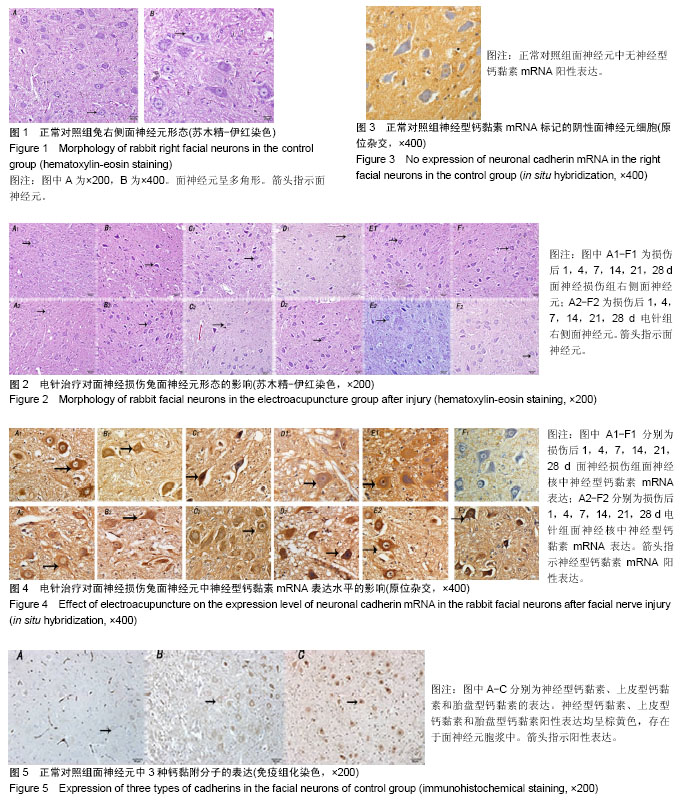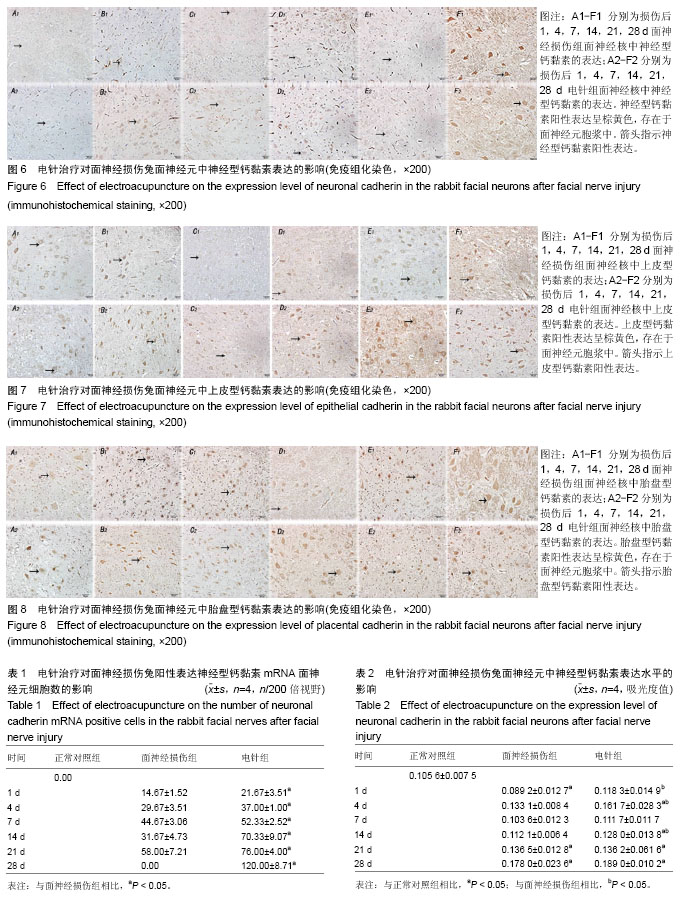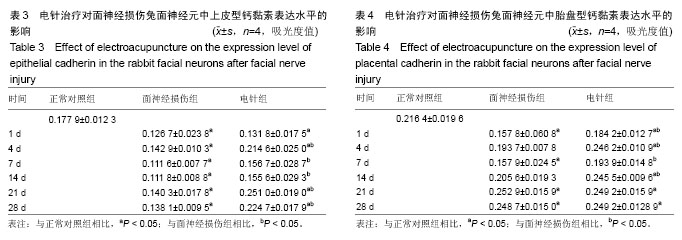中国组织工程研究 ›› 2018, Vol. 22 ›› Issue (28): 4525-4531.doi: 10.3969/j.issn.2095-4344.0845
• 组织构建基础实验 basic experiments in tissue construction • 上一篇 下一篇
电针对面神经损伤后面神经元中神经型钙黏素、上皮型钙黏素和胎盘型钙黏素表达的影响
龚立琼,蔡 虹,费 静,李雷激
- 西南医科大学附属医院耳鼻咽喉头颈外科,四川省泸州市 646000
Effect of electroacupuncture on the expression of N-cadherin, E-cadherin and P-cadherin in the facial neurons after facial nerve injury
Gong Li-qiong, Cai Hong, Fei Jing, Li Lei-ji
- Department of Otorhinolaryngology Head and Neck Surgery, the Affiliated Hospital of Southwest Medical University, Luzhou 646000, Sichuan Province, China
摘要:
文章快速阅读:
.jpg) 文题释义:
神经型钙黏素:与上皮型钙黏素同属于经典型钙黏素,神经型钙黏素的表达升高,上皮型钙黏素的表达降低参与了许多上皮来源肿瘤的恶化、转移与侵袭,还发现神经型钙黏素有抗肿瘤凋亡的作用;其可发挥细胞间的黏附作用和作为细胞应答的信号受体发挥信号转导作用参与神经元细胞和胶质细胞间的黏附、迁移和增殖等,也被证实参与协调面部神经元的集体迁移,并在轴突导向、识别、中枢神经系统和周围神经系统的髓鞘化中发挥着重要作用。
电针疗法:毫针刺入不同穴位后,予以不同的频率、波形的电流刺激可发挥不同的防治作用;临床上常用于各种痛症、痹证和心、胃、肠、膀胱等器官的功能失调,肌肉、韧带、关节的损伤性疾病,麻醉、气血运动障碍、坐骨神经痛、瘫痪等,面瘫是针灸在临床应用中最常见和最有效的优势病种,属于针灸的Ⅰ级病谱,电针疗法作为针灸的发展,常以疏密波电流刺激作为重要的治疗方式应用于临床面瘫。
文题释义:
神经型钙黏素:与上皮型钙黏素同属于经典型钙黏素,神经型钙黏素的表达升高,上皮型钙黏素的表达降低参与了许多上皮来源肿瘤的恶化、转移与侵袭,还发现神经型钙黏素有抗肿瘤凋亡的作用;其可发挥细胞间的黏附作用和作为细胞应答的信号受体发挥信号转导作用参与神经元细胞和胶质细胞间的黏附、迁移和增殖等,也被证实参与协调面部神经元的集体迁移,并在轴突导向、识别、中枢神经系统和周围神经系统的髓鞘化中发挥着重要作用。
电针疗法:毫针刺入不同穴位后,予以不同的频率、波形的电流刺激可发挥不同的防治作用;临床上常用于各种痛症、痹证和心、胃、肠、膀胱等器官的功能失调,肌肉、韧带、关节的损伤性疾病,麻醉、气血运动障碍、坐骨神经痛、瘫痪等,面瘫是针灸在临床应用中最常见和最有效的优势病种,属于针灸的Ⅰ级病谱,电针疗法作为针灸的发展,常以疏密波电流刺激作为重要的治疗方式应用于临床面瘫。
.jpg) 文题释义:
神经型钙黏素:与上皮型钙黏素同属于经典型钙黏素,神经型钙黏素的表达升高,上皮型钙黏素的表达降低参与了许多上皮来源肿瘤的恶化、转移与侵袭,还发现神经型钙黏素有抗肿瘤凋亡的作用;其可发挥细胞间的黏附作用和作为细胞应答的信号受体发挥信号转导作用参与神经元细胞和胶质细胞间的黏附、迁移和增殖等,也被证实参与协调面部神经元的集体迁移,并在轴突导向、识别、中枢神经系统和周围神经系统的髓鞘化中发挥着重要作用。
电针疗法:毫针刺入不同穴位后,予以不同的频率、波形的电流刺激可发挥不同的防治作用;临床上常用于各种痛症、痹证和心、胃、肠、膀胱等器官的功能失调,肌肉、韧带、关节的损伤性疾病,麻醉、气血运动障碍、坐骨神经痛、瘫痪等,面瘫是针灸在临床应用中最常见和最有效的优势病种,属于针灸的Ⅰ级病谱,电针疗法作为针灸的发展,常以疏密波电流刺激作为重要的治疗方式应用于临床面瘫。
文题释义:
神经型钙黏素:与上皮型钙黏素同属于经典型钙黏素,神经型钙黏素的表达升高,上皮型钙黏素的表达降低参与了许多上皮来源肿瘤的恶化、转移与侵袭,还发现神经型钙黏素有抗肿瘤凋亡的作用;其可发挥细胞间的黏附作用和作为细胞应答的信号受体发挥信号转导作用参与神经元细胞和胶质细胞间的黏附、迁移和增殖等,也被证实参与协调面部神经元的集体迁移,并在轴突导向、识别、中枢神经系统和周围神经系统的髓鞘化中发挥着重要作用。
电针疗法:毫针刺入不同穴位后,予以不同的频率、波形的电流刺激可发挥不同的防治作用;临床上常用于各种痛症、痹证和心、胃、肠、膀胱等器官的功能失调,肌肉、韧带、关节的损伤性疾病,麻醉、气血运动障碍、坐骨神经痛、瘫痪等,面瘫是针灸在临床应用中最常见和最有效的优势病种,属于针灸的Ⅰ级病谱,电针疗法作为针灸的发展,常以疏密波电流刺激作为重要的治疗方式应用于临床面瘫。摘要
背景:作者所在课题组前期研究发现周围性面神经损伤能引起神经元中黏附分子的表达变化,而电针穴位治疗周围性面神经损伤的机制尚不清楚。
目的:探讨电针穴位在面神经外周部受损后对中枢面神经元的形态学变化及面神经元中神经型钙黏素、上皮型钙黏素及胎盘型钙黏素表达的影响。
方法:将新西兰大白兔随机分为正常对照组(n=4)、面神经损伤组(n=24)和电针组(n=24)。面神经损伤组与电针组均建立右侧面神经上颊支压榨损伤模型。造模成功后每天对电针组实验兔颊车、地仓、翳风、颧缪、四白、阳白电刺激,选择频率为18-20 Hz、电压为1.5 V的疏密波,另外埋针合谷穴不予以电刺激,针灸每次30 min,1次/d。
结果与结论:①原位杂交结果显示各组兔面神经元中均未见上皮型钙黏素和胎盘型钙黏素mRNA表达,且正常对照组兔面神经元中未见神经型钙黏素mRNA表达,而面神经损伤组和电针组兔面神经元中出现神经型钙黏素mRNA的阳性表达,电针组兔面神经元中神经型钙黏素mRNA阳性细胞数均多于面神经损伤组(P < 0.05);②免疫组化染色可见正常对照组兔面神经元中神经型钙黏素、上皮型钙黏素和胎盘型钙黏素蛋白表达;损伤后1 d时三者表达下降(电针组神经型钙黏素蛋白除外);损伤后1,4,14 d时电针组兔面神经元中神经型钙黏素和胎盘型钙黏素蛋白表达高于面神经损伤组(P < 0.05);损伤后各时间点,电针组上皮型钙黏素蛋白表达均高于面神经损伤组(1 d时除外)(P < 0.05 );③苏木精-伊红染色可见面神经损伤组逐渐出现面神经元变性及类似神经元死亡表现,21 d时神经元开始恢复。电针组变性及类似死亡表现的神经元较面神经损伤组少,且14 d时神经元开始恢复,28 d时2组神经元形态均基本恢复;④提示面神经损伤引起了钙黏素的表达变化,电针治疗减轻了面神经元的变性并促进神经元恢复,这可能与电针促进面神经元中经典钙黏素的高表达密切相关。
中国组织工程研究杂志出版内容重点:组织构建;骨细胞;软骨细胞;细胞培养;成纤维细胞;血管内皮细胞;骨质疏松;组织工程
ORCID: 0000-0002-9531-7400(李雷激)
中图分类号:



.jpg) 文题释义:
神经型钙黏素:与上皮型钙黏素同属于经典型钙黏素,神经型钙黏素的表达升高,上皮型钙黏素的表达降低参与了许多上皮来源肿瘤的恶化、转移与侵袭,还发现神经型钙黏素有抗肿瘤凋亡的作用;其可发挥细胞间的黏附作用和作为细胞应答的信号受体发挥信号转导作用参与神经元细胞和胶质细胞间的黏附、迁移和增殖等,也被证实参与协调面部神经元的集体迁移,并在轴突导向、识别、中枢神经系统和周围神经系统的髓鞘化中发挥着重要作用。
电针疗法:毫针刺入不同穴位后,予以不同的频率、波形的电流刺激可发挥不同的防治作用;临床上常用于各种痛症、痹证和心、胃、肠、膀胱等器官的功能失调,肌肉、韧带、关节的损伤性疾病,麻醉、气血运动障碍、坐骨神经痛、瘫痪等,面瘫是针灸在临床应用中最常见和最有效的优势病种,属于针灸的Ⅰ级病谱,电针疗法作为针灸的发展,常以疏密波电流刺激作为重要的治疗方式应用于临床面瘫。
文题释义:
神经型钙黏素:与上皮型钙黏素同属于经典型钙黏素,神经型钙黏素的表达升高,上皮型钙黏素的表达降低参与了许多上皮来源肿瘤的恶化、转移与侵袭,还发现神经型钙黏素有抗肿瘤凋亡的作用;其可发挥细胞间的黏附作用和作为细胞应答的信号受体发挥信号转导作用参与神经元细胞和胶质细胞间的黏附、迁移和增殖等,也被证实参与协调面部神经元的集体迁移,并在轴突导向、识别、中枢神经系统和周围神经系统的髓鞘化中发挥着重要作用。
电针疗法:毫针刺入不同穴位后,予以不同的频率、波形的电流刺激可发挥不同的防治作用;临床上常用于各种痛症、痹证和心、胃、肠、膀胱等器官的功能失调,肌肉、韧带、关节的损伤性疾病,麻醉、气血运动障碍、坐骨神经痛、瘫痪等,面瘫是针灸在临床应用中最常见和最有效的优势病种,属于针灸的Ⅰ级病谱,电针疗法作为针灸的发展,常以疏密波电流刺激作为重要的治疗方式应用于临床面瘫。